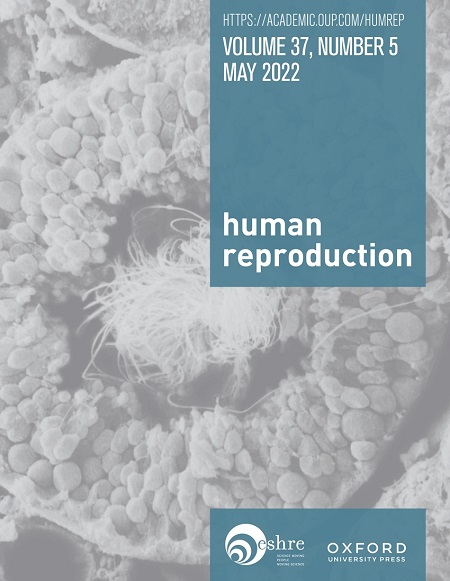1968年至2016年期间,5940名年龄在18-40岁之间被诊断患有乳腺癌的丹麦女性的活产:一项基于登记册的队列研究
IF 6.1
1区 医学
Q1 OBSTETRICS & GYNECOLOGY
引用次数: 0
摘要
研究问题:诊断为乳腺癌的妇女和未患乳腺癌的妇女的活产概率是否不同?它是否受到诊断年龄、时间趋势、胎次、伴侣状态、淋巴结转移和远处转移的存在的影响?1968年至2016年期间,5940名18-40岁乳腺癌确诊女性的活产概率显著低于1 126 478名年龄匹配的未受影响女性,特别是在诊断年龄较高、胎次≥1、已婚、存在淋巴结累及远处转移的女性中。近几十年来,被诊断为乳腺癌的女性的存活率有所增加,在丹麦,被诊断为乳腺癌的女性的5年生存率为。2022年,50岁以上人口占92.2%。化疗会损害卵巢储备,导致卵巢功能不全和不孕。第一次做母亲的年龄正在增加,许多妇女在诊断时尚未完成家庭建设。因此,现在更加注重乳腺癌后的生活质量,包括幸存者生育的可能性。研究表明,被诊断患有癌症的妇女在其生殖寿命期间的生育率下降,然而,专门关注先前被诊断患有乳腺癌的妇女活产概率的研究很少。研究设计、规模、持续时间这是一项全国性、基于登记的队列研究,纳入了1968年至2016年丹麦癌症登记中诊断为乳腺癌的女性,诊断时年龄为18-40岁(n = 5940)。根据诊断时的年龄,每名妇女与背景人群中约190名未受影响的妇女随机配对(n = 1 126 478)。在医学和社会人口学国家人口登记册中对这些妇女进行跟踪,直到分娩、死亡、移民或研究结束(2018年12月31日)。参与者/材料、环境、方法在所有的分析中,我们比较了诊断为乳腺癌的妇女和年龄匹配的对照组之间的活产概率。分析按诊断时的胎次和伴侣关系状况、诊断时的年龄组和诊断年份进行分层。对诊断时淋巴结转移和远处转移的妇女进行了活产概率的分层分析。分析调整了年龄、诊断年份、平价、教育水平和移民状况。研究人群包括1968年至2016年期间诊断为乳腺癌的5940名年龄在18-40岁的女性和年龄匹配的对照组的126478名女性。乳腺癌幸存者的活产概率明显低于年龄匹配的对照组(aHR 0.38 [95% CI 0.35-0.41]);增加诊断年龄(35-40岁:aHR 0.34 [95% CI 0.28-0.40], 18-24岁:0.66 [95% CI 0.46-0.95])、胎次≥1(已产:aHR 0.31 [95% CI 0.27-0.35],未产:0.51 [95% CI 0.45-0.59])和婚姻(已婚:aHR 0.31 [95% CI 0.27-0.36],单身0.53 [95% CI 0.45-0.63])均有负面影响。近几十年来被诊断为乳腺癌增加了未生育妇女活产的可能性;然而,在生育妇女中没有发现同样的联系。在淋巴结受累(48%)和远处转移(3%)的女性中,与未受影响的女性相比,活产的概率分别为aHR 0.30 [95% CI 0.26-0.35]和0.18 [95% CI 0.08-0.42]。局限性和谨慎的原因我们没有关于妇女是否想要孩子或她们是否在接受促性腺毒素治疗前接受了生育保留(FP)的信息。对于最近几十年确诊的女性,随访时间有限。关于他莫昔芬治疗雌激素受体阳性肿瘤的信息可能是相关的,因为它可能会延迟妊娠,从而降低受孕几率。研究结果的更广泛意义我们的研究结果强调了肿瘤生育咨询和计划生育对诊断为乳腺癌的年轻女性的持续重要性,特别是在诊断接近生育期的女性以及存在淋巴结转移和远处转移的女性中。研究经费/竞争利益(S)本研究由丹麦独立研究基金(资助号10.46540/4308-00130B)资助。Anja Pinborg获得了Gedeon Richter、Ferring Pharmaceuticals、Merck A/S和Cryos的资助(支付给机构)和咨询费;Gedeon Richter、Ferring Pharmaceuticals、Merck A/S和Organon的酬金;并支持出席会议和/或旅行(支付给机构)由吉迪恩·里希特。这些公司没有参与这项研究。其余作者无利益冲突需要申报。试验注册号n / a。本文章由计算机程序翻译,如有差异,请以英文原文为准。
Livebirth among 5940 Danish women diagnosed with breast cancer at age 18–40 years between 1968 and 2016: a register-based cohort study
STUDY QUESTION Does livebirth probability differ between women diagnosed with breast cancer and unaffected women and is it impacted by age at diagnosis, time trends, parity, partnership status, and the presence of lymph node metastases and distant metastases? SUMMARY ANSWER Livebirth probability was significantly reduced in 5940 women diagnosed with breast cancer aged 18–40 years during 1968–2016 compared to 1 126 478 age-matched unaffected women, particularly among women with higher diagnosis age, parity ≥ 1, marriage, and the presence of nodal involvement and distant metastases. WHAT IS KNOWN ALREADY The survival rate for women diagnosed with breast cancer has increased over the recent decades, and in Denmark, the 5-year survival rate for women diagnosed <50 years of age was 92.2% in 2022. Chemotherapy can damage the ovarian reserve, resulting in premature ovarian insufficiency and infertility. The age of first-time mothers is increasing, and many women have not yet completed family building at the time of diagnosis. Consequently, greater focus is now placed on quality-of-life following breast cancer, including the possibility of survivors to have children. Studies have shown a decreased fertility rate in women diagnosed with cancer during their reproductive lifespan, however, studies specifically focusing on the probability of livebirth in women previously diagnosed with breast cancer are scarce. STUDY DESIGN, SIZE, DURATION This is a national, register-based cohort study including women diagnosed with breast cancer from the Danish Cancer Register between 1968 and 2016, aged 18–40 years at time of diagnosis (n = 5940). Each woman was randomly matched with ∼190 unaffected women from the background population according to the age at diagnosis (n = 1 126 478). The women were followed in medical and sociodemographic national population registers until childbirth, death, immigration, or end of study (31 December 2018). PARTICIPANTS/MATERIALS, SETTING, METHODS In all analyses, we compared the probability of livebirth between women diagnosed with breast cancer and the age-matched comparison group. Analyses were stratified by parity- and partnership status at diagnosis, age-group at diagnosis, and year of diagnosis. Stratified analyses on the probability of livebirth were conducted for women with lymph-node metastases and distant metastases at the time of diagnosis. Analyses were adjusted for age, year of diagnosis, parity, educational level, and migration status. MAIN RESULTS AND THE ROLE OF CHANCE The study population consisted of 5940 women aged 18–40 years at diagnosis of breast cancer between 1968 and 2016 and 1 126 478 women in the age-matched comparison group. Breast cancer survivors had a significantly lower probability of livebirth than the age-matched comparison group (aHR 0.38 [95% CI 0.35–0.41]); negatively impacted by increasing age at diagnosis (35–40 years: aHR 0.34 [95% CI 0.28–0.40], 18–24 years: 0.66 [95% CI 0.46–0.95]), parity ≥1 (parous: aHR 0.31 [95% CI 0.27–0.35], nulliparous: 0.51 [95% CI 0.45–0.59]), and marriage (married: aHR 0.31 [95% CI 0.27–0.36], single 0.53 [95% CI 0.45–0.63]). Being diagnosed in recent decades increased the probability of livebirth in nulliparous women; however, the same association was not found for parous women. Among women with nodal involvement (48%) and distant metastases (3%), the probability of livebirth compared to unaffected women was aHR 0.30 [95% CI 0.26–0.35] and 0.18 [95% CI 0.08–0.42], respectively. LIMITATIONS, REASONS FOR CAUTION We did not have information on whether the women desired children or whether they underwent fertility preservation (FP) prior to receiving gonadotoxic treatment. For women diagnosed in the most recent decades, the follow-up time was limited. Information on tamoxifen treatment for estrogen receptor-positive tumors could have been relevant, as it likely delays pregnancy and consequently reduces conception probability. WIDER IMPLICATIONS OF THE FINDINGS Our results highlight the continued importance of onco-fertility counseling and FP in young women diagnosed with breast cancer, particularly among women diagnosed toward the end of their reproductive lifespan and those with the presence of lymph node metastases and distant metastases. STUDY FUNDING/COMPETING INTEREST(S) The study is funded by the Independent Research Fund Denmark (Grant ID 10.46540/4308-00130B). Anja Pinborg has received grants (payment to institution) and consultancy fees from Gedeon Richter, Ferring Pharmaceuticals, Merck A/S, and Cryos; honoraria from Gedeon Richter, Ferring Pharmaceuticals, Merck A/S, and Organon; and support for attending meetings and/or travel (payment to institution) from Gideon Richter. These companies had no role in the study. The remaining authors have no conflicts or interests to declare. TRIAL REGISTRATION NUMBER N/A.
求助全文
通过发布文献求助,成功后即可免费获取论文全文。
去求助
来源期刊

Human reproduction
医学-妇产科学
CiteScore
10.90
自引率
6.60%
发文量
1369
审稿时长
1 months
期刊介绍:
Human Reproduction features full-length, peer-reviewed papers reporting original research, concise clinical case reports, as well as opinions and debates on topical issues.
Papers published cover the clinical science and medical aspects of reproductive physiology, pathology and endocrinology; including andrology, gonad function, gametogenesis, fertilization, embryo development, implantation, early pregnancy, genetics, genetic diagnosis, oncology, infectious disease, surgery, contraception, infertility treatment, psychology, ethics and social issues.
 求助内容:
求助内容: 应助结果提醒方式:
应助结果提醒方式:


